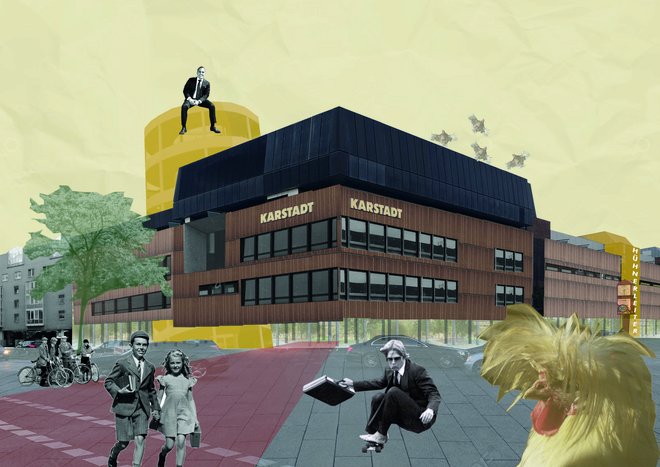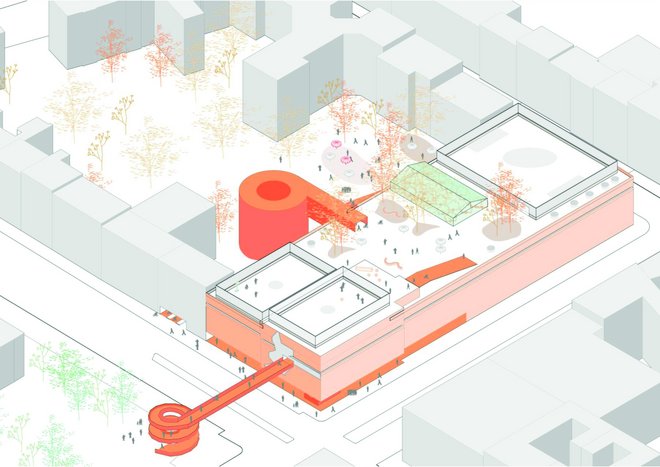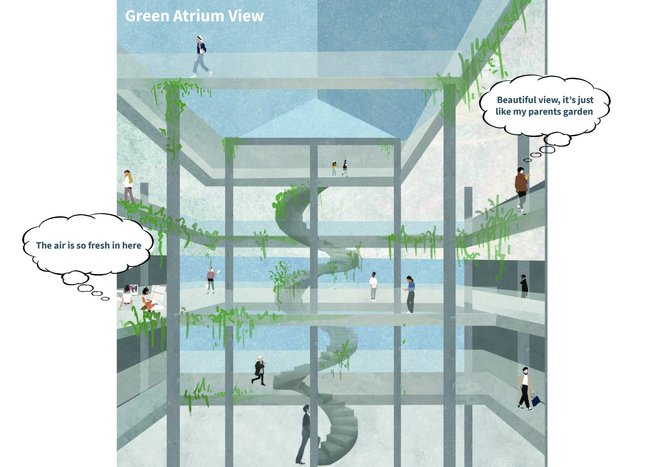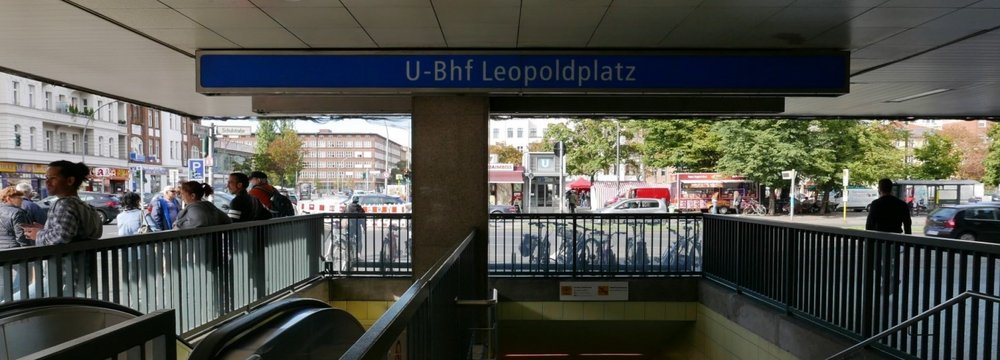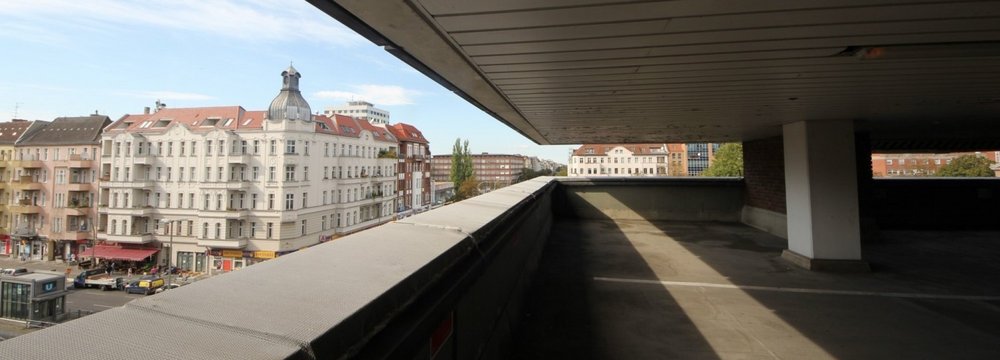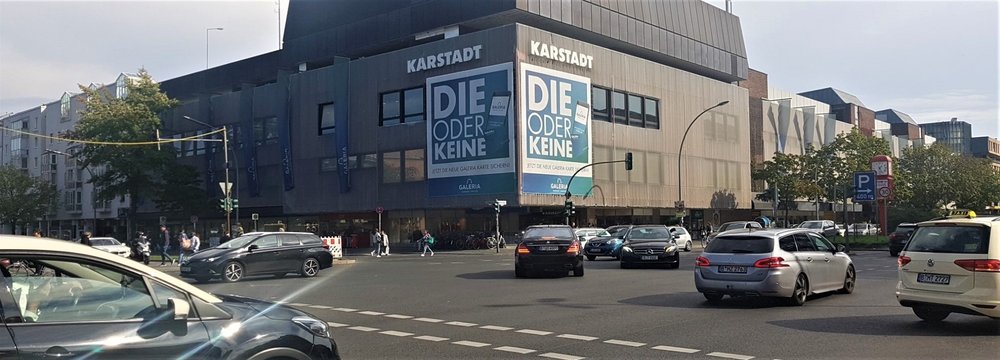Here are the results of the Hackathon 2020!
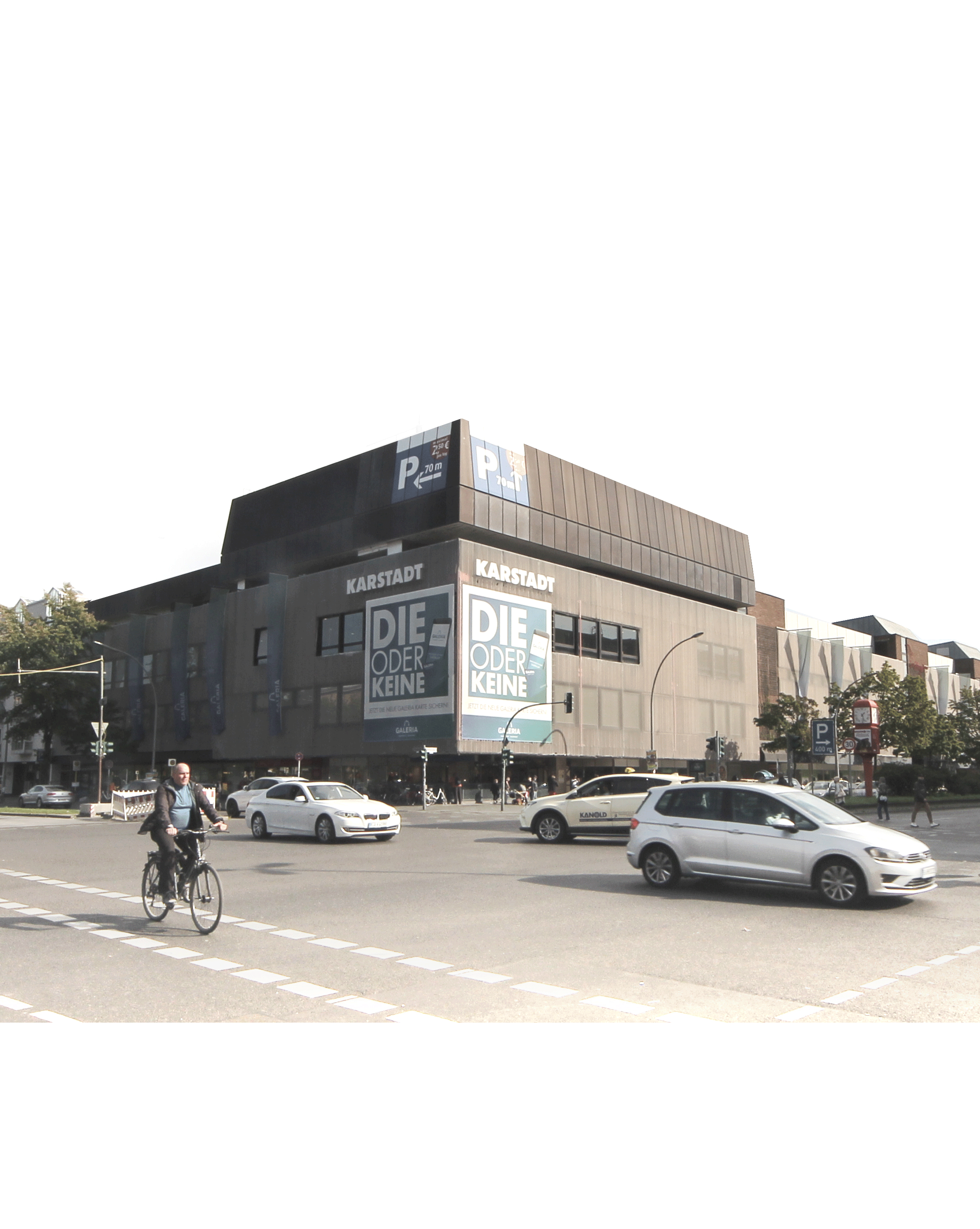
Bauhaus Universität Weimar
Université de Liège | Riga Technical University
In times of digitalization, structures that once shaped our daily life and played a major role in the dynamic of our cities now fall obsolete. The well-established retail model of the department store is one of these species going extinct. In Germany, Karstadt was the largest and best known department store chain that dominated the retail market. Once a symbol of wealth and urban development, the large buildings combined the functions of commercial, social and mobility hubs and occupied key locations in the city. Their disappearance leaves disturbing voids in the urban grid - and is offering a unique opportunity to regain public space, promote diversity of uses and re-conceptualize the “heart of the city”.
The Urban Design Hackathon is a 24h online workshop for international students from four European universities. In mixed teams you will be developing urban design ideas that define the future of the soon to be closed Karstadt department store at Berlin Leopoldplatz in the diverse working-class district of Berlin-Wedding. The aim is to contribute to the development of a productive and resilient city.

International 24h Urban Design Hackathon 2020
from Martina Jacobi
Click the Play button to load and view external content from Vimeo.com.
Automatically load and view external content from Vimeo.com (You can change this setting at any time via our »Data protection policy«.)
FactsHistory of KarstadtSite LocationInstructionsFigure Ground PlanAxonometric ViewReanimate the Dinosaur - Université de Liège Re-Use, Re-Insert, Re-Generate - Ludwig VozWhen the Project serves the Place - Adam PeterkenneGordon Matta-Clark - Physical poetics in material thinking or the thingness of space as an objectHow can nature reanimate the dinosaur? - Elisa Baldin
The building was designed by german Architect Helmut Kriegbaum and built in 1978. Located directly on the central Leopoldplatz, the Karstadt with its corner location and around 130 m facade is the most distinctive property on Müllerstrasse. The property, which is visible from afar, has direct access to the Leopoldplatz underground station and extends over approx. 9,500 m² of floor space across the entire block between Schulstrasse / Leopoldplatz and Antonstrasse.
- First department store 1881 (‘Tuch-, Manufactur- und Confectionsgeschäft Karstadt’) in Wismar by Rudolph Karstadt
- Highpoint 1912 with opening of large store (10.000sqm) in Hamburg (major German city)
- in-house production of clothing, opening of large material store in Berlin in 1911 and a clothing factory in the following year
- 1999 merging of Karstadt and Quelle (mail-order company)
- 2004 dramatic financial situation- start of crisis and further merging with other larger companies
- 2009 insolvency proceedings, selling of several stores
- 2014 sold entirely to Signa Holding
- Januar 2020 merging of the two major department store chains (GALERIA Karstadt Kaufhof GmbH)
- June 2020 Corona-pandemic enhances crisis - discussion of closing 6 out of 10 stores in Berlin (including Leopolplatz) - politcians argue for saving location at Leopoldplatz as it is social and commercial hub of already beaten district (Susanne Fischer, SPD-Fraktion: „Schließung der Filiale am Leopoldplatz für den Wedding und den Bezirk eine Katastrophe“. (Source:https://www.berliner-woche.de/mitte/c-wirtschaft/bezirk-will-um-weddinger-filiale-kaempfen_a277747, 21/09/2020)
- August 2020, the Leopoldplatz site is to be retained for an initial period of three years with an extension option until 2030.
1. Motivation
Corona has revealed: an online urban design studio is possible. Technically advanced online teaching is offering a unique opportunity for international collaboration - without long journeys and large amounts of greenhouse gas being produced.
The Urban Design Hackathon is a case study for online collaboration between European schools of architecture and part of the program International Virtual Academic Collaboration (IVAC) from the DAAD – German Academic Exchange Service. In the long turn, it could lead to common urban design studios as part of the official curriculum. After the pandemic, they can be supplemented with real-life interaction and site visits.
2. The 24h Urban Design Hackathon – Reanimate the Dinosaur
In times of digitalization, structures that once shaped our daily life and played a major role in the dynamic of our cities now fall obsolete. The well-established retail model of the department store is one of these species going extinct. In Germany, Karstadt was the largest and best-known department store chain that dominated the retail market. Once a symbol of wealth and urban development, the large buildings combined the functions of commercial, social, and mobility hubs and occupied key locations in the city. Their disappearance leaves disturbing voids in the urban grid - and is offering a unique opportunity to regain public space, promote diversity of uses, and re-conceptualize the “heart of the city”.
The Urban Design Hackathon is a 24h online workshop for international students from four European universities. In mixed teams, urban design ideas will be developed to define the future of the soon to be closed Karstadt department store at Berlin Leopoldplatz in the diverse working-class district of Berlin-Wedding. The aim is to contribute towards the development of a productive and resilient city.
3. Schedule
Meet & Greet | Friday 27 November
The Meet & Greet is the first encounter of all participants.
17:00 – 17:30 Introduction
- Welcome
- Introduction to the Hackathon format
- Site
- Project task
17:30 – 18:30 Micro Lecture Series (5 minutes introduction + 10 minutes of current discussions)
The aim of the 15-minutes lectures is the informal exchange about ongoing research or interests in the urban design and architecture field as well as a short introduction of the participants. One nominee of each university is invited to give a short presentation divided into 3 parts of 5 minutes each:
- Part 1: introduction of the University, participants and their roles in the Hackathon (Mentors / Students)
- Part 2: a current or significant project in your field of work
- Part 3 (optional): site/task-relevant input and opinion about the possibilities of the refurbishment
18:30 – 19:00 Team Definition + Team Discussion
The randomly assigned mixed teams are revealed and paired with their chosen tutors. In private chat rooms (Breakout rooms in BBB), the team members will have time to get to know each other and their mentors. Furthermore, teams will decide on a name and the three principles that should guide their design.
19:00 – 19:30 Team Presentation
Participants, Tutor, Team Name and three Principles
19:30 – 20:00 Test Run with Platforms
Demonstration of the features of BigBlueButton (BBB) and Conceptboard.
20:00 – 20:30 Q&A
Final discussion about the lectures and time to answer all general questions.
24h Urban Design Hackathon | Day One - Saturday 05 December 2020
12:00 – 13:00 Opening/Introduction/ Task
- Official Opening of the Urban Design Hackathon
- Task Definition and Presentation Requirements
13:00 – 18:00 Section 1
18:00 – 19:00 Feedback with tutora
19:00 – 00:00 Section 2
24h Urban Design Hackathon | Day Two – Sunday 06 December 2020
08:00 – 12:00 Final Section
12:00 – 13:00 Break
13:00 – 16:00 Final Presentation
16:00 – 18:00 Discussion Round / Closing
18:00 – 19:00 Feedback round – Organization Team and Mentors
4. Participants
The three European universities participating in the first edition of the Urban Design Hackathon are
- Université de Liège (B)
- Riga Technical University (LV) and
- Bauhaus Universität Weimar (D).
The workshop is open for bachelor students in their final year and master students in the fields of Architecture and Urbanism. Each university is bringing a group of participants formed by at least one Tutor and 4 – 6 Students.
5. Application
As part of the application process, we ask all participants (students and mentors) to submit a 40-second self-introduction video with the following information:
- Name
- University
- Hometown
- Current City / Where would you like to live?
- Why would you like to participate?
The videos will be collected, stored in a secure cloud folder, and with the participant's consent, made available for all participants to watch. The idea is that we get to know a bit more about each other before the day of the Hackathon.
Here you can see some examples of the Self-Introduction Video and get to know the Organizational Team.
6. Project Requirements and Presentation
The submitted design ideas should propose a new use for the Karstadt building while impacting and integrating its surroundings on an urban scale. Modifications on the existing structure, such as volumetric additions and subtractions, are encouraged. The inclusion of the surrounding area is optional.
For the final submission, teams are requested to present:
- 1 perspective / collage
- Figure-ground plan in scale 1:5.000
- 1 Site plan (roof view) in scale 1:500
- 1 Section in scale 1:500
- Concept diagrams
7. Site Context – Information and Material
Information and material on the project’s site context are available on the day of the Hackathon. A link to a secure cloud folder is provided, in which the following materials are stored:
- Pictures of the site and its surrounding by day and by night (.jpg)
- Short video clips with impressions of the site (.mov)
- Aerial images of the site and its surrounding (.jpg)
- Figure-ground plan (.ai, .pdf)
- 2D plan of the site (.dwg, .pdf)
- Floorplans of Karstadt (.dwg, .pdf)
- 3D Model of the site (.dwg, Mesh)
Pictures and impressions of the site are also available on our Instagram account @urbandesignhackathon.
8. Tutoring
Each participating university has to appoint at least one tutor. The tutors will be randomly assigned to a team of students during the Meet & Greet (Fr 27.11) and will advise them during the Hackathon weekend. Private chat rooms will be provided, where the tutor can communicate with the team and consult with them depending to his/her chosen availability. We ask that at least one hour of consulting is to be provided between the first and the second sections (Sa 05.12, 6 p.m. – 7 p.m.). The tutors are asked to participate in the final discussion round (Sun 06.12, 4 p.m. – 6 p.m.) and in the feedback round, in which the results and the format of the workshop will be discussed and evaluated internally.
9. Platforms and tools
Aligned with the EU Council efforts to achieve “Digital Sovereignty”, we chose to prioritize the use of well-established open-source platforms.
The Meet & Greet as well as the Hackathon online sessions are hosted in the Big Blue Button Platform, which provides us with a previously set up online rooms. The rooms are automatically accessible for participants subscribed to our workshop page in the open-source learning tool Moodle, used by the Bauhaus University Weimar, or by a given link with a password. The subscription in Moodle is made by the organizational team with prior user authorization. The Moodle page also centralizes all the information about the workshop (also available on the Website) and a chat function to contact all participants. Data storage and traffic are provided by SCC, Bauhaus-University’s IT center, that uses its own server infrastructure.
To ensure that all participants are familiar with the tools before the Hackathon, a tutorial will be provided by the organizational team. Furthermore, a short test run will be performed during the Meet & Greet, where all important features will be showcased and explained.
10. Results and Conclusion
The experience and the results gathered in the first edition will help us to understand the challenges posed by rapid digitalization and also identify and explore its innumerous advantages, to establish this new format of international collaboration.
In order to improve further Hackathons, the participants are invited to express their thoughts on all aspects of the event and to participate in a subsequent evaluation process.
With the authorization of the participants, the universities will be allowed to publish the results on their respective websites and research work. Furthermore, the urban design proposals will be featured in the German architecture magazine Bauwelt.






Reanimate the Dinosaur - Université de Liège
from Martina Jacobi
Click the Play button to load and view external content from Vimeo.com.
Automatically load and view external content from Vimeo.com (You can change this setting at any time via our »Data protection policy«.)


Re-Use, Re-Insert, Re-Generate | Center for Industrial Culture in Herstal, Belgium
from Martina Jacobi
Click the Play button to load and view external content from Vimeo.com.
Automatically load and view external content from Vimeo.com (You can change this setting at any time via our »Data protection policy«.)


When the Project serves the Place
from Martina Jacobi
Click the Play button to load and view external content from Vimeo.com.
Automatically load and view external content from Vimeo.com (You can change this setting at any time via our »Data protection policy«.)


Gordon Matta-Clark - Physical poetics in material thinking or the thingness of space as an object
from Martina Jacobi
Click the Play button to load and view external content from Vimeo.com.
Automatically load and view external content from Vimeo.com (You can change this setting at any time via our »Data protection policy«.)


How can nature reanimate the dinosaur?
from Martina Jacobi
Click the Play button to load and view external content from Vimeo.com.
Automatically load and view external content from Vimeo.com (You can change this setting at any time via our »Data protection policy«.)

